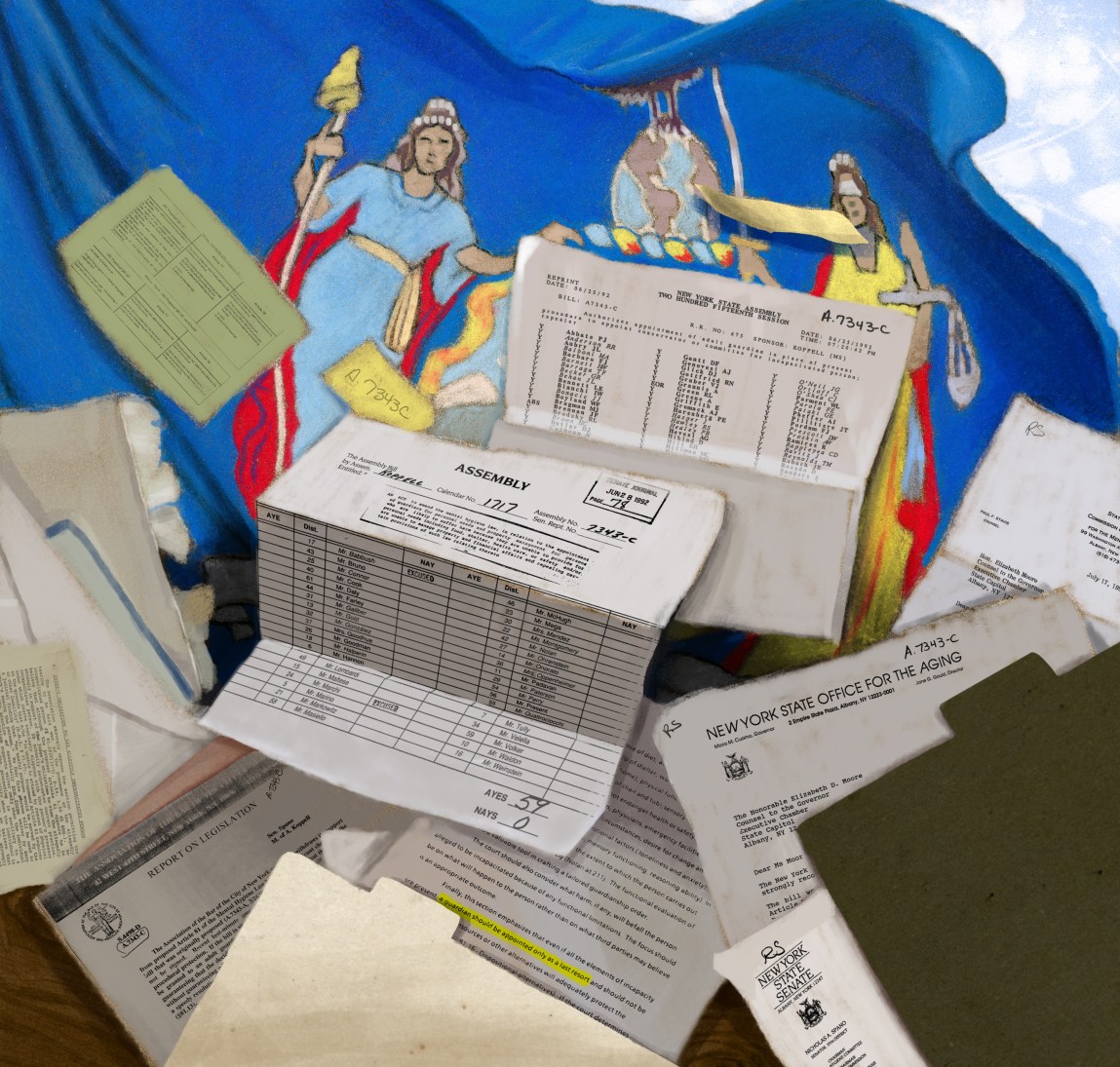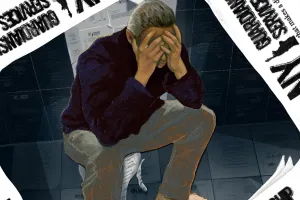Three decades ago, New York’s guardianship system was in desperate need of an overhaul.
Investigators had found that the legal arrangements, which were supposed to protect people who could not care for themselves, had actually deprived individuals of their rights and were poorly monitored, enabling guardians to abuse, neglect and defraud those under their care. In response, state lawmakers passed progressive legislation to codify wards’ civil liberties and safeguard their welfare.
But just five years into the new statute, known as Article 81 of the Mental Hygiene Law, the judges overseeing the system noticed it was insufficient to protect the “unbefriended,” those who have nobody else to help them and little or no money to their name. For them, the state relied on a patchwork system of loosely regulated nonprofits and private attorneys who take the cases pro bono. The setup, judges found, was straining to meet the crushing demand for services.
Charles Devlin, at the time a judge overseeing guardianship cases in Westchester County, traveled to the state capital to lobby for the members of this largely invisible constituency, who are often tucked away in nursing homes and other facilities, far from public view. Specifically, he advocated for the creation of a role of public guardian, a state-funded entity to care for New York’s most vulnerable.
The meetings didn’t go well. “New York state was not interested,” Devlin recalled in an interview. “They said, ‘Nope, sorry, goodbye.’”
In the years since, others have made similar trips, sounding alarms about New York’s overtaxed guardianship system, which now covers 28,600 people statewide — 60% of whom live in New York City. But state lawmakers have done little in response.
Today the system is in shambles, a ProPublica investigation published earlier this month found. There are not enough guardians to serve the needs of the “unbefriended,” nor are there enough overseers to check guardians’ work. And the quality of the care provided by the groups that do cater to this vulnerable population can be shockingly poor.
For example, the organization featured in the ProPublica report, New York Guardianship Services, placed one of its wards in a dilapidated, rat-infested Queens home for years, often without heat, taking $450 a month from her meager income as compensation while ignoring her complaints, according to interviews and internal records. She was one of about 400 wards who relied on the company to manage their financial and personal affairs. A company executive said he couldn’t answer questions about any specific ward, adding in a statement that NYGS is “accountable to the Court and our annual accounts and reports are scrutinized by Court appointed examiners and any issues would be addressed.” He also said our story was inaccurate but provided no details.
Experts say there are fixes policymakers can and should make to close the gap between Article 81’s promise and its practice. Here are six.
Public Financing for Guardians
As Arthur Diamond, then the supervising guardianship judge in Nassau County, bluntly put it to lawmakers in 2018: “It’s very, very sad that the state of New York has not been able to find a way to take care of this population.”
Following the roundtable where Diamond spoke, the state Legislature awarded Nassau and Suffolk counties $250,000 each to run pilot programs to find guardians for those without the means to pay for them. But the funding wasn’t renewed, and the state has not established a dedicated financing stream to cover the costs of guardianships for thousands of poor New Yorkers. Meanwhile, two of the organizations in the small nonprofit network that serves as the backbone of the system abruptly shuttered due to financial hardship.
Guardianship Access New York, a coalition of nonprofits that’s seeking to improve guardianships, has proposed that the Legislature secure $15 million annually “in sustained funding that would comprehensively support guardianship services statewide.” Advocates say those guardians don’t have to be lawyers, as traditionally has been the case, and should include social workers and other specialists familiar with the needs of the elderly and infirm.
Others have argued for the creation and funding of a separate public entity tasked with serving wards who have little or no money and nobody else to look after them. Some states, including Illinois and Delaware, have such an office, though experts warn they’re no panacea and without proper support and oversight can fail wards as easily as any other guardian can.
Bolstering the Regulatory Ranks
Prior to a small bump in 2019, examiner pay hadn’t been increased in 14 years, resulting in thin ranks of reviewers to ensure proper oversight of guardians. Lawyers make just a few hundred dollars per case annually — a feeble payday that they say isn’t worth the effort.
A recent judicial guardianship task force report has recommended a pay raise for examiners so that the courts can recruit an adequate bench. Today New York City has only 157 examiners to monitor the care and finances of more than 17,000 wards.
Experts say the system needs more court clerks too. These workers play a key role in the oversight process, reviewing examiners’ reports before passing them up to judges, who ultimately sign off on the paperwork. But Diamond and others have said that deep budget cuts to the courts from more than a decade ago drastically reduced the ranks of these employees. More than 400 people — including clerks — were laid off following state budget cuts in 2011. This funding, they said, should be restored.
Finally, Diamond said, judges could be more proactive about monitoring case activity, scheduling regular compliance conferences so that guardians and examiners are forced to explain to the court what accounts for delays in completing their reports.
Strengthening the Examination Process
Though Article 81 requires guardians to file wards’ annual financial accounts by May of the following year, there is no such deadline for examiners. In practice, that means that accounts of wards can — and do — go years without any kind of examination. In the case we featured in our investigation, we found the ward’s file was missing reviews for four whole years, during which time she faced horrendous living conditions and the threat of eviction. The examiner did not respond to questions about the missing reports for that period.
Our review also found that examiners tend to focus almost exclusively on financial paperwork when determining the care and condition of wards. They rarely, if ever, see wards in person.
Experts say that requiring face-to-face check-ins can prevent guardians from hiding horrific situations and that judicial leaders tasked with appointing and overseeing examiners should require such visits. That’s what happens in Davidson County, Tennessee, which includes Nashville: Social services workers there visit wards, review their medical records and interview guardians and their doctors.
Mandating More Training for Guardians
Only ten states nationwide require professional guardians to be certified by the Center for Guardianship Certification, the only national group of its kind. A handful of other states require guardians to be licensed by state agencies, in the same way as plumbers, barbers and other skilled professions.
New York requires neither. Under Article 81, prospective guardians need only take a daylong course to get certified.
Advocates say the state should mandate more stringent training. Guardians should also be required to take regular refresher courses, just as lawyers are, experts say.
Vetting Nonprofit Providers
Once certified, private guardians are required to attest that they haven’t been found to have violated any criminal, civil or professional rules. Nonprofits, however, undergo no such vetting. In fact, they are not even required to provide proof of their charitable status.
That’s a critical gap in oversight given the outsized role nonprofit organizations currently play in caring for the unbefriended.
In our investigation, we found that NYGS repeatedly represented itself as a nonprofit in its court filings and promotional material as it took on more and more cases. Yet authorities told us that the organization is not registered as a charity with the state attorney general’s office nor does it have tax-exempt status from the Internal Revenue Service.
Sam Blau, NYGS’ chief financial officer, declined to answer questions about the company’s tax status, but said in a statement that “a large percentage of our cases are done completely Pro Bono,” which “is certainly in line with our mission to help people of minimal financial means.”
Policing the nonprofit sector is critical, experts say, especially since charitable organizations are exempt from court rules that cap the number of cases and the amount of compensation guardians can receive annually.
Issuing Guidance for Proper Staffing
One of the key indicators of a failing guardianship system involves caseloads that are higher than a 20:1 ratio of wards to staffers, according to a recent report by the country’s premier guardianship researchers. Some states, like Colorado and Virginia, recommend such a cap. But New York offers no guidance.
At New York Guardianship Services, the group ProPublica featured in its report this month, the ward-to-staff ratio has topped 83:1. One worker who was responsible for dozens of wards every day said she quit after six months because she couldn’t keep up with the unrelenting needs of the company’s clients. NYGS did not respond to questions about its caseloads.
Caseload caps, experts say, would improve services and help states more easily identify potential guardianship abuse.












